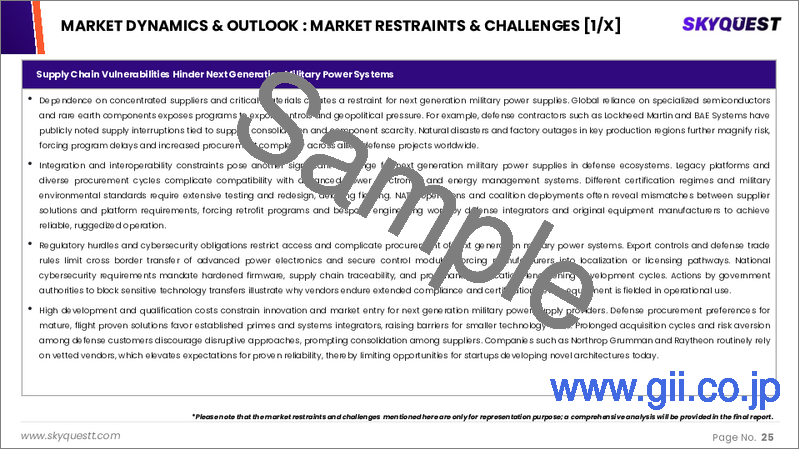|
|
市場調査レポート
商品コード
1796413
次世代軍用電源の市場規模・シェア・成長分析 (電源別、用途別、技術別、容量別、地域別):産業予測 (2025~2032年)Next Generation Military Power Supply Market Size, Share, and Growth Analysis, By Power supply, By Applications, By Technology, By Capacity, By Region - Industry Forecast 2025-2032 |
||||||
|
|||||||
| 次世代軍用電源の市場規模・シェア・成長分析 (電源別、用途別、技術別、容量別、地域別):産業予測 (2025~2032年) |
|
出版日: 2025年08月20日
発行: SkyQuest
ページ情報: 英文 177 Pages
納期: 3~5営業日
|
- 全表示
- 概要
- 目次
世界の次世代軍用電源の市場規模は2023年に61億米ドルと評価され、2024年の64億1,000万米ドルから2032年には95億4,000万米ドルに成長し、予測期間(2025-2032年)のCAGRは5.1%で成長する見通しです。
防衛インフラの近代化と任務能力の強化に重点を置くことで、軍事用電力システムへの投資が大幅に増加しています。電子戦、デジタル通信、ミッションクリティカルなハードウェアの進歩は、この市場の主要促進要因です。UAV、ミサイルシステム、電子対策機器の配備拡大により、軽量で効率的かつ堅牢な電源が求められています。軍事作戦がセンサー・フュージョンやサイバー・セキュア・コミュニケーションのような先進技術を取り入れるにつれて、信頼性の高いモジュール式電源への需要が高まり続けています。次世代の軍事用電源は、過酷な環境に耐え、高度な戦闘システムとシームレスに統合し、ミッションクリティカルな条件下での運用信頼性を確保するよう設計されています。そのため、防衛機関は、全体的な効率を高め、故障リスクを最小限に抑えるために、これらのソリューションを優先的に採用し、この分野の将来性を世界的に強化しています。
目次
イントロダクション
- 分析目的
- 市場範囲
- 定義
分析手法
- 情報調達
- 二次・一次データの手法
- 市場規模予測
- 市場の想定と制約
エグゼクティブサマリー
- 市場の概要と展望
- 需給動向の分析
- セグメント別の機会分析
市場力学と展望
- 市場概要
- 市場規模
- 市場力学
- 促進要因と機会
- 抑制要因と課題
- ポーター分析
市場の主な考察
- 主な成功要因
- 競合の程度
- 主な投資機会
- 市場エコシステム
- 市場魅力度指数 (2024年)
- PESTEL分析
- マクロ経済指標
- バリューチェーン分析
- 価格分析
- 技術分析
- ケーススタディ
世界の次世代軍用電源の市場規模・CAGR:電源別 (2025~2032年)
- 市場概要
- ポータブル電源
- 再生可能エネルギーシステム
- 燃料電池システム
- ハイブリッドパワーシステム
世界の次世代軍用電源の市場規模・CAGR:用途別 (2025~2032年)
- 市場概要
- 地上部隊
- 航空宇宙
- 海軍
- 無人航空機
世界の次世代軍用電源の市場規模・CAGR:技術別 (2025~2032年)
- 市場概要
- 先進バッテリー技術
- エネルギーハーベスティング
- 固体電池
- スマート電力管理システム
世界の次世代軍用電源の市場規模・CAGR:容量別 (2025~2032年)
- 市場概要
- マイクロ(0~100 W)
- 小容量(100~500W)
- 中容量(500 W~2 kW)
- 大容量(2kW~10kW)
世界の次世代軍用電源の市場規模・CAGR (2025~2032年)
- 北米
- 米国
- カナダ
- 欧州
- ドイツ
- スペイン
- フランス
- 英国
- イタリア
- その他欧州
- アジア太平洋
- 中国
- インド
- 日本
- 韓国
- その他アジア太平洋
- ラテンアメリカ
- ブラジル
- その他ラテンアメリカ
- 中東・アフリカ
- GCC諸国
- 南アフリカ
- その他中東・アフリカ
競合情勢
- 上位5社の比較
- 主要企業の市場ポジショニング (2024年)
- 主要企業が採用した戦略
- 市場の近年の動向
- 主要企業の市場シェア (2024年)
- 主要企業のプロファイル
- 企業概要
- 製品ポートフォリオ分析
- セグメント別シェア分析
- 収益の前年比比較 (2022~2024年)
主要企業プロファイル
- Raytheon Technologies
- Vicor Corporation
- CurtissWright
- Honeywell
- Thales Group
- SAFT
- Northrop Grumman
- BAE Systems
- Emerson Electric
- Rockwell Collins
- General Dynamics
- L3Harris Technologies
- Leonardo
結論と提言
Global Next Generation Military Power Supply Market size was valued at USD 6.1 billion in 2023 and is poised to grow from USD 6.41 billion in 2024 to USD 9.54 billion by 2032, growing at a CAGR of 5.1% during the forecast period (2025-2032).
The focus on modernizing defense infrastructures and enhancing mission capabilities is significantly boosting investments in military power systems. Advancements in electronic warfare, digital communications, and mission-critical hardware are key drivers of this market. The increasing deployment of UAVs, missile systems, and electronic countermeasure equipment demands lightweight, efficient, and robust power supplies. As military operations embrace advanced technologies like sensor fusion and cyber-secured communications, the demand for reliable and modular power sources continues to rise. Next generation military power supplies are being engineered to withstand harsh environments, seamlessly integrate with advanced combat systems, and ensure operational reliability under mission-critical conditions. Therefore, defense agencies are prioritizing these solutions to enhance overall efficiency and minimize failure risks, strengthening the future of this sector globally.
Top-down and bottom-up approaches were used to estimate and validate the size of the Global Next Generation Military Power Supply market and to estimate the size of various other dependent submarkets. The research methodology used to estimate the market size includes the following details: The key players in the market were identified through secondary research, and their market shares in the respective regions were determined through primary and secondary research. This entire procedure includes the study of the annual and financial reports of the top market players and extensive interviews for key insights from industry leaders such as CEOs, VPs, directors, and marketing executives. All percentage shares split, and breakdowns were determined using secondary sources and verified through Primary sources. All possible parameters that affect the markets covered in this research study have been accounted for, viewed in extensive detail, verified through primary research, and analyzed to get the final quantitative and qualitative data.
Global Next Generation Military Power Supply Market Segments Analysis
Global Next Generation Military Power Supply Market is segmented by Power supply, Applications, Technology, Capacity and region. Based on Power supply, the market is segmented into Portable Power Supply, Renewable Energy Systems, Fuel Cell Systems and Hybrid Power Systems. Based on Applications, the market is segmented into Ground Forces, Aerospace, Naval Forces and Unmanned Aerial Vehicles. Based on Technology, the market is segmented into Advanced Battery Technologies, Energy Harvesting, Solid State Batteries and Smart Power Management Systems. Based on Capacity, the market is segmented into Micro (0-100 W), Small (100-500 W), Medium (500 W - 2 kW) and Large (2 kW - 10 kW). Based on region, the market is segmented into North America, Europe, Asia Pacific, Latin America and Middle East & Africa.
Driver of the Global Next Generation Military Power Supply Market
The Global Next Generation Military Power Supply market is significantly driven by defense organizations' efforts to transition from outdated power systems to advanced, next-generation solutions. This shift is fueled by a strong demand for military power supplies that enhance energy efficiency and facilitate the integration of renewable energy sources. Additionally, the increasing reliance on unmanned systems in various military operations underscores the necessity for innovative power supplies that can support these technologies effectively. As military initiatives emphasize modernization, there is a clear focus on adopting power solutions that not only meet current operational needs but also prepare for future challenges.
Restraints in the Global Next Generation Military Power Supply Market
The Global Next Generation Military Power Supply market faces significant challenges due to the extensive investment required for research and development, alongside the integration of advanced materials and cutting-edge manufacturing technologies. These initial costs can be substantial, potentially acting as a deterrent for various participants, particularly smaller defense agencies and device manufacturers. The financial burden associated with these developments can restrict access to innovation and limit competition, as not all entities possess the resources to invest heavily at the onset. This situation creates an uneven playing field, hindering growth and advancement within the sector.
Market Trends of the Global Next Generation Military Power Supply Market
The Global Next Generation Military Power Supply market is witnessing a significant trend towards the adoption of hybrid and renewable energy-based power systems. As defense forces prioritize sustainability and energy efficiency, there is an increasing integration of technologies such as fuel cells, advanced batteries, and renewable energy sources. This shift not only enhances operational capabilities for longer-duration missions but also supports unmanned and forward-operating platforms. The growing emphasis on reducing the environmental footprint and increasing autonomy in military operations drives innovation and investment in these advanced power solutions, positioning them as vital components in modern military strategy.
Table of Contents
Introduction
- Objectives of the Study
- Scope of the Report
- Definitions
Research Methodology
- Information Procurement
- Secondary & Primary Data Methods
- Market Size Estimation
- Market Assumptions & Limitations
Executive Summary
- Global Market Outlook
- Supply & Demand Trend Analysis
- Segmental Opportunity Analysis
Market Dynamics & Outlook
- Market Overview
- Market Size
- Market Dynamics
- Drivers & Opportunities
- Restraints & Challenges
- Porters Analysis
- Competitive rivalry
- Threat of substitute
- Bargaining power of buyers
- Threat of new entrants
- Bargaining power of suppliers
Key Market Insights
- Key Success Factors
- Degree of Competition
- Top Investment Pockets
- Market Ecosystem
- Market Attractiveness Index, 2024
- PESTEL Analysis
- Macro-Economic Indicators
- Value Chain Analysis
- Pricing Analysis
- Technology Analysis
- Case Studies
Global Next Generation Military Power Supply Market Size by Power supply & CAGR (2025-2032)
- Market Overview
- Portable Power Supply
- Renewable Energy Systems
- Fuel Cell Systems
- Hybrid Power Systems
Global Next Generation Military Power Supply Market Size by Applications & CAGR (2025-2032)
- Market Overview
- Ground Forces
- Aerospace
- Naval Forces
- Unmanned Aerial Vehicles
Global Next Generation Military Power Supply Market Size by Technology & CAGR (2025-2032)
- Market Overview
- Advanced Battery Technologies
- Energy Harvesting
- Solid State Batteries
- Smart Power Management Systems
Global Next Generation Military Power Supply Market Size by Capacity & CAGR (2025-2032)
- Market Overview
- Micro (0-100 W)
- Small (100-500 W)
- Medium (500 W - 2 kW)
- Large (2 kW - 10 kW)
Global Next Generation Military Power Supply Market Size & CAGR (2025-2032)
- North America (Power supply, Applications, Technology, Capacity)
- US
- Canada
- Europe (Power supply, Applications, Technology, Capacity)
- Germany
- Spain
- France
- UK
- Italy
- Rest of Europe
- Asia Pacific (Power supply, Applications, Technology, Capacity)
- China
- India
- Japan
- South Korea
- Rest of Asia-Pacific
- Latin America (Power supply, Applications, Technology, Capacity)
- Brazil
- Rest of Latin America
- Middle East & Africa (Power supply, Applications, Technology, Capacity)
- GCC Countries
- South Africa
- Rest of Middle East & Africa
Competitive Intelligence
- Top 5 Player Comparison
- Market Positioning of Key Players, 2024
- Strategies Adopted by Key Market Players
- Recent Developments in the Market
- Company Market Share Analysis, 2024
- Company Profiles of All Key Players
- Company Details
- Product Portfolio Analysis
- Company's Segmental Share Analysis
- Revenue Y-O-Y Comparison (2022-2024)
Key Company Profiles
- Raytheon Technologies
- Company Overview
- Business Segment Overview
- Financial Updates
- Key Developments
- Vicor Corporation
- Company Overview
- Business Segment Overview
- Financial Updates
- Key Developments
- CurtissWright
- Company Overview
- Business Segment Overview
- Financial Updates
- Key Developments
- Honeywell
- Company Overview
- Business Segment Overview
- Financial Updates
- Key Developments
- Thales Group
- Company Overview
- Business Segment Overview
- Financial Updates
- Key Developments
- SAFT
- Company Overview
- Business Segment Overview
- Financial Updates
- Key Developments
- Northrop Grumman
- Company Overview
- Business Segment Overview
- Financial Updates
- Key Developments
- BAE Systems
- Company Overview
- Business Segment Overview
- Financial Updates
- Key Developments
- Emerson Electric
- Company Overview
- Business Segment Overview
- Financial Updates
- Key Developments
- Rockwell Collins
- Company Overview
- Business Segment Overview
- Financial Updates
- Key Developments
- General Dynamics
- Company Overview
- Business Segment Overview
- Financial Updates
- Key Developments
- L3Harris Technologies
- Company Overview
- Business Segment Overview
- Financial Updates
- Key Developments
- Leonardo
- Company Overview
- Business Segment Overview
- Financial Updates
- Key Developments






